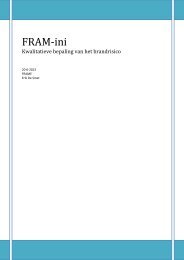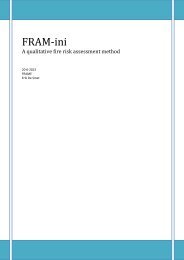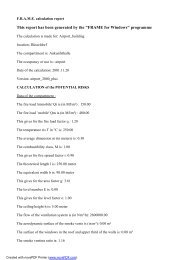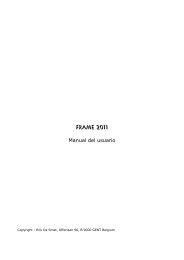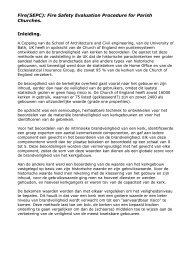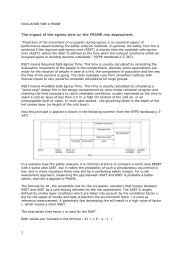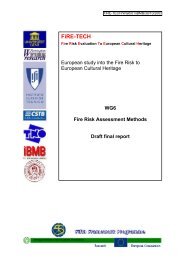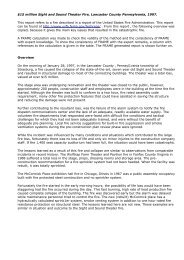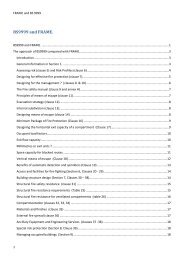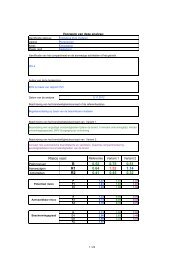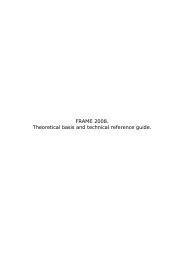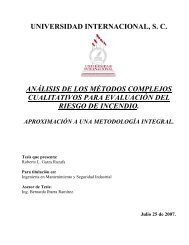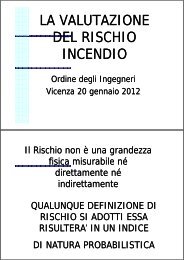FRAME Calculation examples book. - FRAME Fire Risk Assessment ...
FRAME Calculation examples book. - FRAME Fire Risk Assessment ...
FRAME Calculation examples book. - FRAME Fire Risk Assessment ...
You also want an ePaper? Increase the reach of your titles
YUMPU automatically turns print PDFs into web optimized ePapers that Google loves.
F.R.A.M.E.<br />
These improvements result in higher values for the normal protection ( N=0.66) , for the<br />
special protection ( S=1.63 and F = 1.45) and for the escape protection (U = 2.65) . The<br />
calculated risk levels are R =0.62 , R1=0.81 and R2 =0.44 . This means that an adequate level<br />
of safety can be obtained for all 3 aspects of the fire risk assessment.<br />
Case study 21. Sweets manufacturer safety improvement program.<br />
A sweets manufacturer asked fire safety consultant in 2004 for a fire risk analysis and<br />
improvement program for his factory. The consultant used <strong>FRAME</strong> to support his findings and<br />
recommendations. A total of 7 <strong>FRAME</strong> calculations were made for this job.<br />
The plant has his own water storage tank for fire fighting with an electrical driven fire pump<br />
and a hydrant network, but no sprinklers. The nearest fire station ( day time manned) is at 10<br />
-15 min. from the plant. The plant has a guard service outside working hours and a small first<br />
intervention team during working hours.<br />
A first series of calculation was made for the production unit.<br />
The building is 125 m long and 67 m wide, mainly ground floor but with upper levels for about<br />
30 % of the ground floor area. Construction is mainly concrete and brickwork, and ceilings are<br />
at an average of 4 m. The fire load is estimated at 900 MJ/m² . For hygienic reasons, there are<br />
no openable windows or smoke vents. About 60 persons per shift work in the factory, and<br />
there are 8 exit doors. The value of the factory is estimated at 5 Million Euro.<br />
Some part of the production process is heated by steam or hot water and there is a zone with<br />
an occasional dust hazard without proper dust removal system.<br />
The 1 st calculation was made for the factory “as is” and gave the following results : R =2.17 ,<br />
R1=1.58 and R2 = 1.91, which indicate an unacceptable high risk level. As Ro, the initial risk<br />
was = 2.60 , sprinkler protection was recommendable<br />
A 2 nd calculation was made with sprinklers, and resulted in the following risk levels: R=1.01,<br />
R1=0.80 and R=0.73 or a well protected risk.<br />
As the investment in sprinklers was beyond the financial possibilities of the plant, an<br />
alternative improvement program was proposed: Solve the dust problem by adding a dust<br />
extraction system and compartimentation of that part of the process and installation of an<br />
addressable automatic fire detection (rate of rise detectors mostly). This resulted in the<br />
following risk levels R=1.31 R1=0.82 and R2=0.96<br />
This would lead to an acceptable level of risk for the personnel and the business and also<br />
reduce the property loss expectancy to about 20 % for an affordable investment.<br />
The next calculations were made for the finished good warehouse.<br />
This was a 82.5 m x 32.5 m large steel building, 11 m high with a rack storage of palletised<br />
goods. The mobile fire load was estimated at 12000 MJ/m². It was accessible from 3 sides.<br />
No smoke venting was provided. Warehouse value was estimated at 1 million Euro.<br />
The building has no heating, the electrical installation was code compliant, handling operations<br />
were done with electrical lift trucks with a battery charger station outside the warehouse.<br />
The impact of the warehouse on the business is limited: warehouse capacity is available at<br />
other locations too.<br />
36



